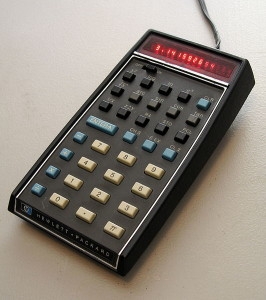This Month In Tech History – First Handheld Scientific Calculator

First Handheld Scientific Calculator Released.
January 4, 1972
Hewlett-Packard introduced the first handheld scientific calculator, the HP-35. The precision of the calculator was greater than most mainframe computers of its time. For such a technological achievement, the name of the calculator is simply derived from the fact that it has 35 buttons.
History
In about 1970 HP co-founder Bill Hewlett challenged his co-workers to create a “shirt-pocket sized HP-9100”. At the time, slide rules were the only practical portable devices for performing trigonometric and exponential functions, as existing pocket calculators could only perform addition, subtraction, multiplication, and division. Introduced at $395 (equivalent to $2,366 in 2018), Like HP’s first scientific calculator, the desktop 9100A, it used Reverse Polish Notation (RPN) rather than what came to be called “algebraic” entry. The “35” in the calculator’s name came from the number of keys.
The original HP-35 was available from 1972 to 1975. In 2007 HP announced the release of the “retro”-look HP 35s in commemoration of the original HP-35.
The HP-35 was named an IEEE Milestone in 2009.
Description
The calculator used a traditional floating decimal display for numbers that could be displayed in that format but automatically switched to scientific notation for other numbers. The fifteen-digit LED display was capable of displaying a ten-digit mantissa plus its sign and a decimal point and a two-digit exponent plus its sign. The display used a unique form of multiplexing, illuminating a single LED segment at a time rather than a single LED digit because HP research had shown that this method was perceived by the human eye as brighter for equivalent power. Light emitting diodes were relatively new at the time and were much dimmer than high-efficiency diodes developed in subsequent decades.
The calculator used three “AA”-sized NiCd batteries assembled into a removable proprietary battery pack. Replacement battery packs are no longer available, leaving existing HP-35 calculators to rely on AC power, or their users to rebuild the battery packs themselves using available cells. An external battery charger was available and the calculator could also run from the charger, with or without batteries installed.
Internally, the calculator was organized around a serial (one-bit) processor chipset made under contract by Mostek, processing 56-bit floating-point numbers, representing 14-digit BCD numbers.
Still widely used today, By definition, a scientific calculator is a calculator designed to help you calculate science, engineering, and mathematics problems. It has way more buttons than the standard calculator that just lets you do your four basic arithmetic operations of addition, subtraction, multiplication, and division.
Have you ever got the hang of using one? I know I’ve not.
While our partners at Recycle Your Tec wouldn’t necessarily recycle these items, they do accept redundant IT such as Laptops, PC, TV, Tablets and more, why not check them out at www.recycleyourtec.com




Trackbacks & Pingbacks
… [Trackback]
[…] Read More Infos here: almwholesaleltd.com/this-month-in-tech-history-first-handheld-scientific-calculator/ […]
creative writing dissertation proposal https://helpon-doctoral-dissertations.net/
best dissertation https://dissertations-writing.org/
dissertation writing experts https://mydissertationwritinghelp.com/
mla dissertation citation https://help-with-dissertations.com/
doctoral dissertation help your https://dissertationwriting-service.com/
books thesis dissertation help https://buydissertationhelp.com/
triple diamond free slots https://slotmachinegameinfo.com/
i won $4 at penny slots https://www-slotmachines.com/
cashman casino slots free https://download-slot-machines.com/
free slots real cash https://beat-slot-machines.com/
operation slots https://slot-machine-sale.com/
gsn casino slots free https://slotmachinesforum.net/
triple diamond free slots https://slotmachinesworld.com/
hollywood fun slots https://pennyslotmachines.org/
slots free games https://candylandslotmachine.com/
caesars casino free slots https://freeonlneslotmachine.com/
river slots download https://2-free-slots.com/
dating a gay porn star https://speedgaydate.com/
indian gay chat https://gay-buddies.com/
gay video cam chat broadcast self https://gaytgpost.com/
chubby chub gay dating https://gaypridee.com/
cleveland gay chat line numbers https://bjsgaychatroom.info/
2operatives
Comments are closed.